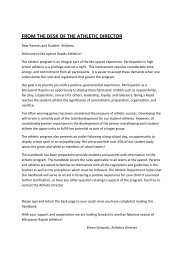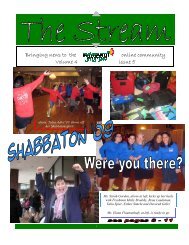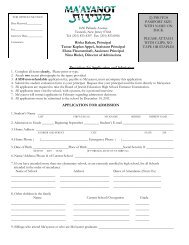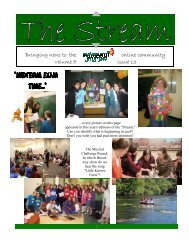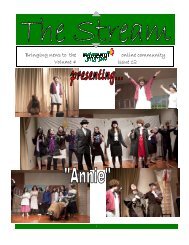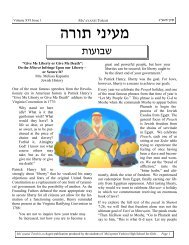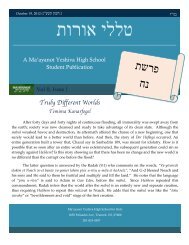Alumnae Newsletter, May 2012 - Ma'ayanot Yeshiva High School for ...
Alumnae Newsletter, May 2012 - Ma'ayanot Yeshiva High School for ...
Alumnae Newsletter, May 2012 - Ma'ayanot Yeshiva High School for ...
You also want an ePaper? Increase the reach of your titles
YUMPU automatically turns print PDFs into web optimized ePapers that Google loves.
Issue 3, <strong>May</strong> <strong>2012</strong>Ma’ayanot <strong>Alumnae</strong> <strong>Newsletter</strong>In this issuePage 2Page3- 4Dvar Torah from Mrs.Tamar Appel,Assistant PrincipalDvar Torah fromEsther (Schachter,‘00) FridmanPage 5Page 6The class of 2002celebrates their tenyear reunionWelcome back!From our <strong>Alumnae</strong> CoordinatorDear <strong>Alumnae</strong>,Page 7 <strong>Alumnae</strong> Mazel Tovs!Page 8 Ma’ayanot in theNewsWe are excited to share the third edition of the Ma’ayanot <strong>Alumnae</strong> newsletter.Over the last few months, we have been happy to welcome back many of ouralumnae who have joined us <strong>for</strong> our annual scholarship dinner, Torahton andother Ma’ayanot programs. The mission of our alumnae association is to bridgeour alumnae with our current school and, through your participation, we are ableto achieve that goal.This edition of the alumnae newsletter includes Divrei Torah from Mrs. TamarAppel, Assistant Principal at Ma’ayanot, as well as by Esther (Schachter, ‘00)Fridman. The class of 2002 recently celebrated their ten-year high schoolreunion at Mocha Bleu. The event was chaired by Dahlia (Fein, ’02)Goldbrenner, Estee (Sce, ’02) Nadav, and Rebecca (Glass, ’02) Humphrey. Anoverview of the event can be found within the newsletter.We look <strong>for</strong>ward to seeing you at future alumnae events!Please join our Facebook group to receive alumnae updates.Best,Ariella Steinreich (’07)Pictures from the <strong>Alumnae</strong> facebook group
Dear <strong>Alumnae</strong>,I would like to share with you and elaborate on a thought I shared with the currentMa’ayanot student body at the beginning of this year’s Color War, which took placeduring the week of parshiot Vayakhel-Pekudei. These two parshiot are essentiallyabout the technical features of building the mishkan and everything in it. They are,in fact, so predominantly about the building of the mishkan that they have famouslybegged the question – why do the first three pesukim of Vayakhel begin with anapparently irrelevant reiteration of the Shabbat prohibitions? Hazal, includingRashi, have long answered this question by explaining that the juxtaposition ofShabbat and the mishkan is meant to stress that even the construction of such aholy sanctuary does not take precedence over Shabbat observance.Mrs. Tamar Appel,Assistant PrincipalWhy is that? Why is it that the significance of Shabbat transcends that of building the structure that is to serveas the setting <strong>for</strong> avodat Hashem? Certainly, we are metzuvim to emulate Hashem by ceasing creative workas He did after beriat ha-olam. However, given two commands of such great importance, we might not havetaken <strong>for</strong> granted the imperative to have Shabbat take precedence over the building of the mishkan.Abraham Joshua Heschel’s commentary on the beauty of Shabbat can provide us with one meaningfulanswer to this question. Heschel (as others be<strong>for</strong>e him) writes that Judaism is, very clearly, a time-basedreligion rather than one whose observance is dependent upon a particular space. It seems to me that we livethe reality of Judaism as independent of place: as Jews of the golah, we have seen that yahadut can beobserved and even flourishes outside of Eretz Yisrael. We do ask <strong>for</strong> the Beit Ha-Mikdash to be rebuilt, beezratHashem, and we know that outside of Eretz Yisrael, not every single mitzvah can be fulfilled – but weunderstand implicitly, through centuries of experience, that Judaism is transportable.Recognizing that our religion is most rooted in temporal rather than spatial conditions, Heschel devotes hisbook The Sabbath to the value of time in our practice and hashkafa. He writes that Shabbat is the mostsignificant time unit, because it exists autonomously. It is independent of the months as established by theviewing of the moon, and as opposed to chagim, it is unrelated to seasons or to agricultural progressions.Shabbat was determined at the very beginning of the world, exclusively by Hashem, through the act ofcreation. This description of the significance of time in our lives, as epitomized by Shabbat, brings to mind astatement made by Shimshon Raphael Hirsch, who devoted considerable energy toward preventing Jews whowere drawn to Christianity from leaving the fold: “The Jew’s catechism,” he wrote, choosing his wordspointedly, “is his calendar.”Taking Heschel’s description to heart, we might better appreciate the precedence that observing Shabbat tookover building the mishkan. Even while building this glorious structure, B’nei Yisrael were not allowed to castaside the observance of the mitzvah that constitutes the definitive reminder of Hashem’s creation of the world.Furthermore, even while building this glorious structure, they were not to <strong>for</strong>get that our most important valuesare rooted in time– that which is invisible but most essential to the structure of our lives and observance –rather than in anything material.In speaking to our students about Color War, I shared with them my hope that even as they would be focusingon altering the physical appearance of the building to reflect the themes of Shabbat, Yamim Noraim, andShalosh Regalim, they would also use the event as an opportunity to reflect on the significance of these holydays that transcend the corporeal. For you, our alumnae, I hope that even in the absence of a commonbuilding to enter every day <strong>for</strong> learning, growing, singing, dancing, and having fun, you feel the impact of youryears at Ma’ayanot -- of your classmates, teachers, and shared experiences – that connect you to each otherand to all of us in a powerful and moving way. We certainly feel that way about all of you.2
תורה שבעל פה Importance ofBy Esther (Schachter) Fridman, class of 2000The Torah describes the holiday of Shavuot a few times in Sefer Shemot, Vayikraand Dvarim. However, in none of these descriptions are we given a date <strong>for</strong>Shavuot. In Perek 23 of Sefer Vayikra, we are told that Pesach falls on the fifteenthday of the first month (23:5-6), but several verses later, when discussing Shavuot,the Torah is vague about when to celebrate the holiday. In Vayikra 23:15-16, weare told to count 50 days from the day after “the Shabbat”. However, we are not toldwhat is the meaning of “the Shabbat”.This was a source of great controversy during the time of the second Beitתורה שבעל and the תורה שבכתב Hamikdash. The Perushim, who accepted both theunderstood “the Shabbat” to mean Pesach, which was discussed in the verses ,פהpreceding the discussion of Shavuot (Vayikrah 23:4-8). There<strong>for</strong>e, the Perushimbegan counting fifty days beginning on the second day of Pesach, as we continue todo today.On the other hand, the Tzedukim, who accepted only the שבכתב ,תורה understood“the Shabbat” to literally mean “Shabbat”, as in the seventh day of the week; theythere<strong>for</strong>e began counting the fifty days on the day after the first Shabbat afterPesach (the first Sunday after Pesach began). Due to this custom <strong>for</strong> counting the50 days, Shavuot always fell out on a Sunday <strong>for</strong> the Tzedukim.Esther (’00) currentlylives in Modiin, Israel,with her husband,Beny, and their twosons, Yedidiah (5)and Yakir (2).Esther telecommutesto several U.S. lawfirms as a freelanceimmigrationparalegal. She hasauthored a number ofarticles and frequentlydispenses advice onimmigration matters.When discussing the holiday of Shavuot in Perek 23 of Sefer Vayikra, the Torah does not link the holiday withrather, Shavuot is linked to the harvest. This can explain the Tzedukim’s misinterpretation of “the ;מתן תורהShabbat”. The Gemara in Menachot 65a mentions a discussion between a Tzeduki and R’ Yochanan benZakkai in which the Tzeduki explains why Shavuot is always held on a Sunday. According to the Tzeduki,Shavuot gave the people a long weekend to rest from the harvest.However, as we know, Shavuot is linked not just the harvest, but also תורה .מתן However, the Torah does notgive a date <strong>for</strong> מתן תורה either. So how was it decided that Shavuot is the celebration of the day we received?מתן תורה if we do not have an exact date <strong>for</strong> הר סיני the Torah atBe<strong>for</strong>e we had an established Hebrew calendar, the date of Shavuot could vary from year to year, dependingon how many days were in the months of Nissan and Iyar in a given year. The Gemara in Rosh Hashana 6bstates that any month on the Hebrew calendar could potentially be 29 or 30 days. If Nissan and Iyar were both30 days, Shavuot would be on the fifth of Sivan. If Nissan and Iyar were both 29 days, Shavuot would be onthe seventh of Sivan. If one was 30 and the other was 29, Shavuot would be on the sixth of Sivan.The Gemara in Shabbat 86b-88b describes the arguments over the date of תורה ,מתן which is either the sixthor seventh of Sivan. But we see from the Gemara in Rosh Hashana that be<strong>for</strong>e we had a set calendar,.מתן תורה Shavuot could fall on the fifth of Sivan, which has no relation toIt can be said that because there was no other holiday commemorating תורה ,מתן Chazal chose to link theholiday of Shavuot with מתן תורה since Shavuot falls out around the time of תורה .מתן Shavuot is there<strong>for</strong>ecalled זמן מתן תורתנו – the time the Torah was given, and not the “date” the Torah was given.3
However, there is a link between the two names of Shavuot: חג הקציר and מתן תורתנו .זמן In SeferShemot, the Torah describes the :שלוש רגלים 23:15 describes Pesach alone, while 23:16 describesboth Shavuot הקציר) (חג and Succot האסיף) .(חג The combination of these two holidays shows thatthey are linked: harvest is one part of the agricultural process, but the produce must also begathered at the end of the year to complete the process. So too, מתן תורה was also in two parts:The Beit Halevi, in his commentary on Parshat Yitro, explains that .תורה שבעל פה and תורה שבכתבthe תורה שבכתב is identical to the one given at Har Sinai; one may not add to it or subtract from it.However, the תורה שבעל פה has no bounds or limits and in every generation laws are furtherdeveloped. Because each new generation has different issues, תורה שבעל פה is expanded to adapt<strong>for</strong> modern day concerns. Like the agricultural process, we need these two parts of the Torah inorder to be the Jewish People. If we reject the תורה שבעל פה like the Tzedukim, we will cease toexist as a Nation.Shavuot is called זמ ן מתן תורתנו and not קבלת תורתנו .זמן The Torah was given to us only once atHar Sinai. It is our task to accept the Torah through study, observance, and transmitting it to.תורה שבעל פה and תורה שבכתב others; this is done through both the4
Reported by Dahlia (Fein, ’02) GoldbrennerOn Sunday, <strong>May</strong> 6th, the Class of 2002 held their ten-yearreunion at Mocha Bleu. The table was filled with laughter fromall of the memories shared and from hearing about current lifesituations. It was great to catch up with everyone, especiallyteachers: Ms. Flaumenhaft, Rabbi Helfgot and Coach. Thehighlight of the reunion was at the end, when Coach escortedsome alumnae around the <strong>Ma'ayanot</strong> building. A special thankyou to Estee Sce Nadav, Dahlia Fein Goldbrenner and RebeccaGlatt Humphrey <strong>for</strong> organizing the event. A good time was hadby all who came!Reunion organizers Dahlia(Fein, ’02) Goldbrenner andEstee (Sce, ’02) NadavMembers of the class of 2002 celebrate their ten year reunionwith their teachers, Coach, Rabbi Helfgot, and Ms. F!5
Ma’ayanot welcomes back the following alumnae who have joined us <strong>for</strong> many programs!Chaya Kanarfogel (’11)Rachel Friedman (’10)Svetlana (Fleyshmakher, ’05) HarelBatya Sadek (’10)Sara (Alt, ’06) SimchiMichelle Zivari (’11)After school on Wednesday, February 22 nd , <strong>Ma'ayanot</strong> held a joint learning program and a trip tothe YU Sefarim Sale <strong>for</strong> our current students and alumnae. Thank you to Rachel Shulman (’08),Margot Reinstein (’09), Penina Cohen (’10), Atara Clark (’10), Batya Sadek (’10) <strong>for</strong> joining us.Are you interested inwriting a Dvar Torah<strong>for</strong> Ma’ayanot’sweekly e-newsletter,The Stream?Email Mrs. SchmucklerHave you joined theMa’ayanot <strong>Alumnae</strong>Facebook page?Get the latest <strong>Alumnae</strong>Mazel Tovannouncements andhappenings of the<strong>Alumnae</strong> Association!Would you like toreceive Ma’ayanotweekly e-newsletter?If you do not alreadyreceive it and would liketo, please contact Mrs.Schmuckler.Are you followingMa’ayanot’sJewish StudiesBlog?6
Please let us knowabout S’machothappening in your livesby sending an email toAriella SteinreichMazel Tov to Michal (Adler, ’00) and Rabbi Ovi Jacob on the birth of their son.Mazel Tov to Devorah (Stein, ’01) and Natan Edelman on the birth of their daughter, Emunah.Mazel Tov to Adrianne (Eichen, ’01) and Scott Burgher on the birth of their son, Raanan.Mazel Tov to Yaffi Adler ('03) on her marriage to Moti Loterstein.Mazel Tov to Ariella Wruble ('03) on her engagement to Eric Bloom.Mazel Tov to Dena (Katz, '04) and Rabbi Avi Block on the birth of their son.Mazel Tov to Eliana Grosser (’05) on her marriage to Chaim Rotenberg.Mazel Tov to Shani Zitter (’06) on her engagement to A.J. Berkowitz.Mazel Tov to Sarah Silvestri (’07) on her engagement to Josh Bernstein.Mazel Tov to Nava Unterman (’07) on her marriage to Eitan Ulmer.Mazel Tov to Rebecca Margulies ('09) on her marriage to Yossi Pasternak.Mazel Tov to Atara Staiman (’09) on her engagement to Zach Bienenfeld.7
As members of the Ma’ayanot family, we all look <strong>for</strong>ward to hearing about Ma’ayanot’s accomplishments.Siemens Winners Featured on "Teaneck Patch"Recently, Ilana Teicher, a senior at <strong>Ma'ayanot</strong> <strong>Yeshiva</strong> <strong>High</strong> <strong>School</strong> <strong>for</strong>Girls, was named a regional finalist in the Siemens Competition inScience, Mathematics and Technology. Juniors Eliana Applebaum andAriella Applebaum were named semi-finalists.To read about the achievements of these three <strong>Ma'ayanot</strong> students inthe prestigious Siemens Science Competition, as reported by the onlinenewsletter "Teaneck Patch," click here. Mazel Tov to the Teicher andApplebaum families, including Rachel Teicher (’06) and KaylaApplebaum (’10).Ma’ayanot participates in “The Challenge”As reported in The Stream, <strong>Ma'ayanot</strong>’s "Challenge Team" attendedthe second round of the MSG Challenge competition, a generalknowledge trivia game show competition which is broadcast ontelevision by Cablevision. After winning Round 1 in November, theteam advanced to Round 2, where they faced off this week againstRandolph (New Jersey) <strong>High</strong> <strong>School</strong>. The team included seniorsTamar Novetsky (Captain), Ilana Teicher, Chana Garbow, YaffaCohen and Talia Moss, who were accompanied by a group ofseniors who came to cheer them on, as well as some parents andthe trip chaperone, Ms. Gordon. Mazel Tov to the Novetsky, Teicher,Garbow, Cohen and Moss families including Rachel Teicher (’06), Michael Novetsky (’07), Rikki Novetsky (’10) ontheir sisters’ amazing wins!8



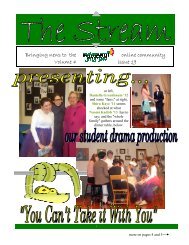
![Issue 18].pub - Ma'ayanot Yeshiva High School for Girls](https://img.yumpu.com/48719735/1/190x245/issue-18pub-maayanot-yeshiva-high-school-for-girls.jpg?quality=85)


